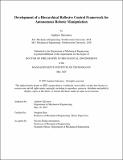Development of a Hierarchical Reflexive Control Framework for Autonomous Robotic Manipulation
Author(s)
SaLoutos, Andrew
DownloadThesis PDF (54.44Mb)
Advisor
Kim, Sangbae
Terms of use
Metadata
Show full item recordAbstract
Within the field of robotic manipulation, much research focus has been placed on improving perception and planning algorithms, assuming that the actions output by these high-level planners will be easily achieved by the robot systems. However, to surpass human manipulation performance, fast and robust execution of manipulation plans is just as critical as improved perception and planning methods. In this thesis, we introduce the last centimeter problem, which states that the most difficult part of grasp execution is when less than a centimeter remains between fingertips and an object, and contact is imminent. To solve this problem, we propose a reflexive control framework, which is a manipulation control architecture that decouples low-level, high-bandwidth behaviors, which we call reflexes, from broad high-level plans. The reflexes are fast, autonomous reactions to local sensing information that are designed to add robustness to high-level manipulation plans while also reducing the necessary complexity of manipulation planning problems. To deploy our reflexes, we design hardware platforms that incorporate high-bandwidth actuation and low-latency tactile sensing, allowing us to maximize the reactive capabilities of the overall manipulation system. We validate our approach through studies on teleoperated grasping and autonomous planar grasping, which show that our reflexive controllers increase manipulation speed and robustness. Then, we perform extensive simulation studies for autonomous grasping in SE(3), conducting experiments with single objects as well as cluttered scenes, using a variety of state-of-the-art grasp planners. Our results show greatly improved grasp robustness with our reflexive controllers, across all object types and grasp planners. Further experiments show that the benefits of our reflexes persist across sets of objects that are larger, heavier, and more slippery, and with increasing magnitudes of errors in the executed grasp poses. While this thesis demonstrates that the reflexive control framework is effective at increasing grasp robustness during picking, our framework is constructed in a way that is amenable to extension to other tasks, like in-hand manipulation or constrained object placement, as well as application to more complex grippers, such as those with three or more dexterous fingers and more diverse sensing.
Date issued
2025-05Department
Massachusetts Institute of Technology. Department of Mechanical EngineeringPublisher
Massachusetts Institute of Technology